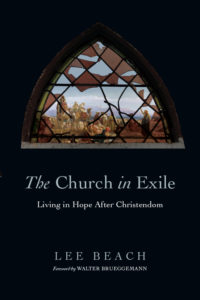
The Church in Exile: Living in Hope After Christendom
Lee Beach. The Church in Exile: Living in Hope After Christendom. Downers Grove, IL: InterVarsity Press, 2015, pp. 240. $25 (paperback).
Reviewed by Kelsey L. Lambright
In The Church in Exile, Lee Beach lifts up a biblical theology of exile as a hopeful way to understand the current state of the Western church. By engaging biblical scholarship and practical theology, Beach explores the similarities between the post-Christendom existence of the Western church and the exilic communities found in the Old and New Testaments. He believes that this motif can not only help explain the present struggles of the Western church, but can also provide a hopeful view of God’s people as a people who thrive in the margins of society.
The book begins with a broad assessment of the church in the West. Beach, a professor of Christian ministry and a pastor with the Christian and Missionary Alliance in Canada, writes from the context of the North American church. He explains, “The church is one of those former power brokers who once enjoyed a place of influence at the cultural table but has been chased away from its place of privilege and is now seeking to find where it belongs amid the ever-changing dynamics of contemporary culture” (46). Because of the declining social significance of the church in the West, Beach believes that it has entered a form of exile, where it should “stand apart from culture and offer an alternative way of life” (47).
In order to make his point, Beach examines biblical stories, such as those of Esther, Jonah, and Peter. He sees in these stories clear examples of God’s people as an exiled people who are called to live in holiness, hope, and prophetic imagination. Using these biblical examples as a framework through which to view the current church’s situation, Beach offers practical steps for today’s exiled communities to take. The last few chapters of the book lift up a potential way forward for the Western church today, including a call to recognize its situatedness as exiles, to focus on orthopraxy, and to develop a robust eschatology.
With a vantage-point that is unabashedly Western and conservative, Beach might not be easy to swallow for a global or theologically liberal audience. For example, he strongly condemns certain ecclesiologies and somewhat trivializes exile and marginalization. Although he claims that the church in the West has moved from the center to the margins, the reality might be much more complicated (47). The Western church is certainly less centered in society than it was, but it maintains significant power and entanglement with the surrounding culture. While Beach addresses some of these complexities, they do not seem to adequately account for the variety of theological traditions and for the global nature of the church, even in the West.
However, Beach’s book is timely and extremely accessible, offering to pastors and scholars alike a gentle way into the missional church conversation. With one hand, he skillfully puts influential biblical and missional theologians in dialogue, and with the other he lays out practical implications for exilic language in local churches. Even if his readers disagree with some of his insights, they would certainly find within the book’s pages thought-provoking critiques of culture and hopeful visions for the future of the church.
Kelsey L. Lambright, PhD Student, Princeton Theological Seminary
